#Boilerplate
Explore tagged Tumblr posts
Text

Photo showing the major features of the Big Joe boilerplate capsule.
Date: 1959
NASA ID link
#Big Joe 1#BJ-1#Mercury Boilerplate#Boilerplate#NASA#Mercury Program#Project Mercury#Mercury#1959#my post
55 notes
·
View notes
Text
Slimming down
Like all software metrics, "lines of code" shouldn't be applied blindly.
Today my software WIP's LoC metric is rapidly declining because I've created C++ macros to generate boilerplate code. I'm talking code I used to copy and paste every time I needed it.
This is the kind of refactoring I love, because it means less code to maintain in the future. Fewer chances for coding errors. Less scrolling through source code to find the interesting parts.
And in this case, I believe it also uncovered (and solved) a bug. So a big win all around.
But from a strict "lines of code" perspective, this would be considered a step backward.
4 notes
·
View notes
Text
Ship Mobile Fast
Ship your AI apps in days, not weeks.
Save weeks of development time with our React Native Expo Boilerplate. In App Purchases, Open AI, Anthropic, Replicate, Fal AI, GlueStack, AI Proxy Backend, Firebase, Supabase, Admob, and more.
Ship Mobile Fast AI Wrapper is Live!🔥
For those who want to build AI applications…
Now, you can create the apps you envision in just 1-2 days.😎
Integrations with OpenAI, Anthropic, Replicate, and Fal AI. Protect your API keys from being stolen with AI Proxy Backend.
*
Pro (Best for Casual Apps):
In App Purchases (RevenueCat) Google Mobile Ads Authentication Flow Onboarding Flow Push Notifications Multi Language Support Error Tracking App/User Analytics Lifetime Updates Private Discord Channel Access Supabase⚡️ GlueStack Version StyleSheet Version
*
AI Wrapper (Best for AI Projects):
In App Purchases (RevenueCat) Google Mobile Ads Authentication Flow Onboarding Flow Push Notifications Multi Language Support Error Tracking App/User Analytics Lifetime Updates Private Discord Channel Access Firebase🔥 AI Proxy Backend (API Keys Secured🔒) Open AI & Anthropic Replicate AI & Fal AI Ready-to-Use AI Templates
*
Ship Mobile Fast: https://shipmobilefast.com/?aff=1nLNm
Telegram: ahmetmertugrul


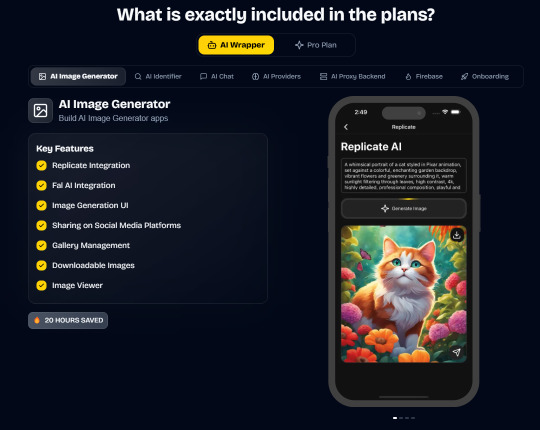
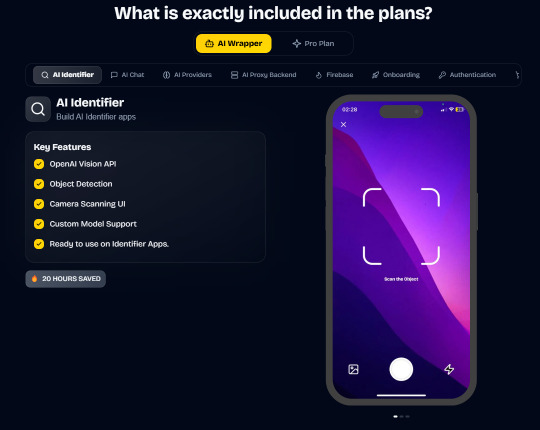
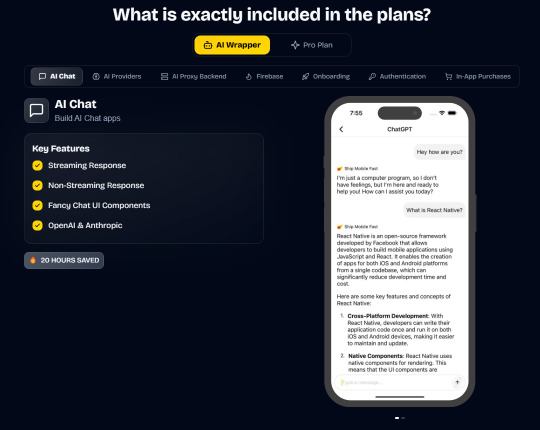

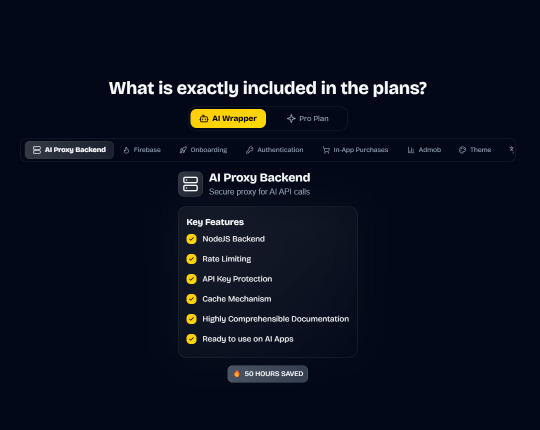
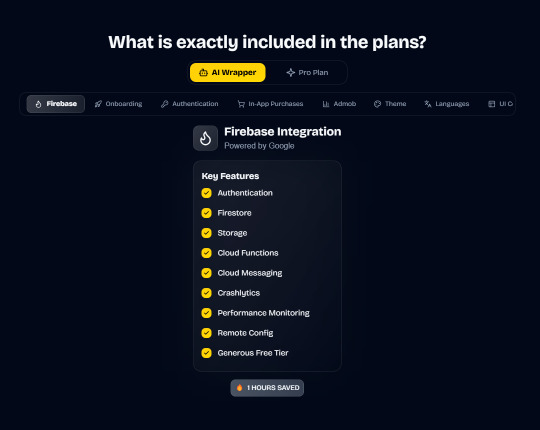
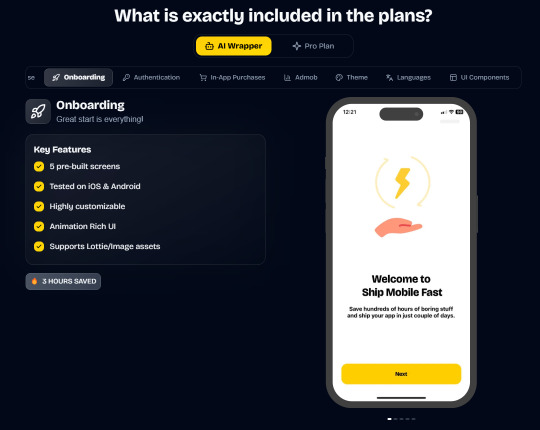


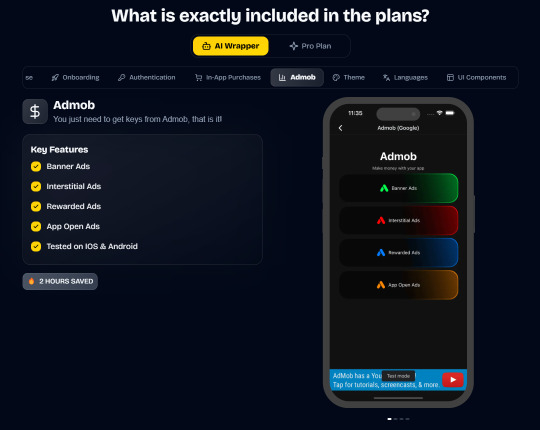

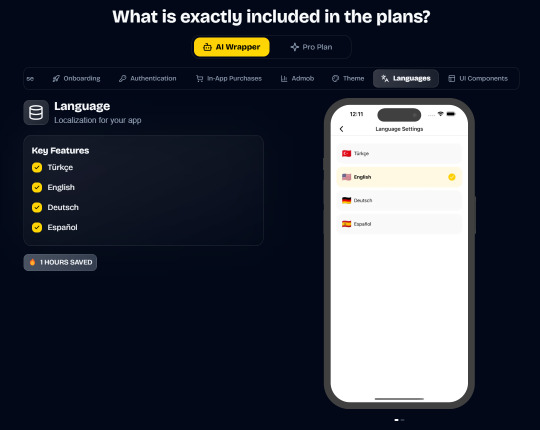
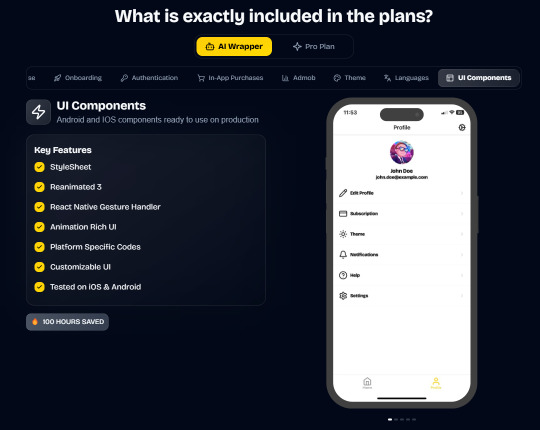
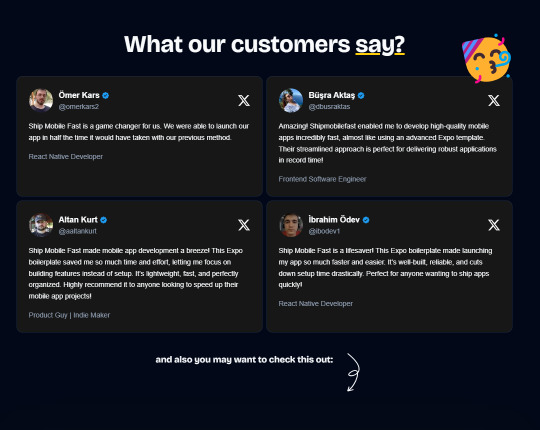
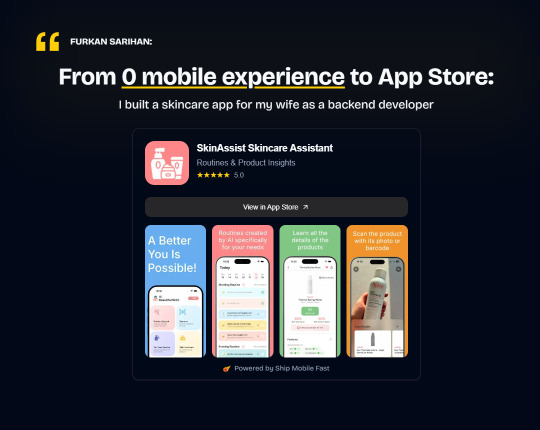

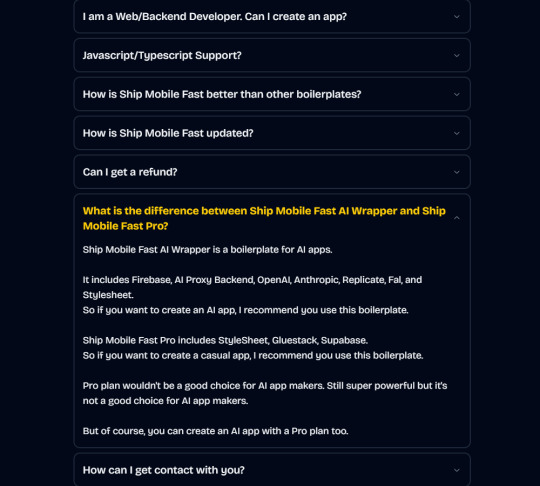

#ai#app#ship#mobile#fast#openai#claude#deepseek#proxy#api#admob#ads#firebase#supabase#falai#backend#ui#ux#replicate#revenuecat#google#expo#boilerplate#template#wrapper
2 notes
·
View notes
Text
🚀 How EasyLaunchpad Helps You Launch a SaaS App in Days, Not Months

Bringing a SaaS product to life is exciting — but let’s be honest, the setup phase is often a painful time sink. You start a new project with energy and vision, only to get bogged down in the same tasks: authentication, payments, email systems, dashboards, background jobs, and system logging.
Wouldn’t it be smarter to start with all of that already done?
That’s exactly what EasyLaunchpad offers.
Built on top of the powerful .NET Core 8.0 framework, EasyLaunchpad is a production-ready boilerplate designed to let developers and SaaS builders launch their apps in days, not months.
💡 The Problem: Rebuilding the Same Stuff Over and Over
Every developer has faced this dilemma:
Rebuilding user authentication and Google login
Designing and coding the admin panel from scratch
Setting up email systems and background jobs
Integrating Stripe or Paddle for payments
Creating a scalable architecture without cutting corners
Even before you get to your actual product logic, you’ve spent days or weeks rebuilding boilerplate components. That’s precious time you can’t get back — and it delays your path to market.
EasyLaunchpad solves this by providing a ready-to-launch foundation so you can focus on building what’s unique to your business.
🔧 Prebuilt Features That Save You Time
Here’s a breakdown of what’s already included and wired into the EasyLaunchpad boilerplate:
✅ Authentication (with Google OAuth & Captcha)
Secure login and registration flow out of the box, with:
Email-password authentication
Google OAuth login
CAPTCHA validation to protect against bots
No need to worry about setting up Identity or external login providers — this is all included.
✅ Admin Dashboard Built with Tailwind CSS + DaisyUI
A sleek, responsive admin panel you don’t have to design yourself. Built using Razor views with TailwindCSS and DaisyUI, it includes:
User management (CRUD, activation, password reset)
Role management
Email configuration
System settings
Packages & plan management
It’s clean, modern, and instantly usable.
✅ Email System with DotLiquid Templating
Forget about wiring up email services manually. EasyLaunchpad includes:
SMTP email dispatch
Prebuilt templates using DotLiquid (a Shopify-style syntax)
Customizable content for account activation, password reset, etc.
✅ Queued Emails & Background Jobs with Hangfire
Your app needs to work even when users aren’t watching. That’s why EasyLaunchpad comes with:
Hangfire integration for scheduled and background jobs
Retry logic for email dispatches
Job dashboard via admin or Hangfire’s built-in UI
Perfect for automated tasks, periodic jobs, or handling webhooks.
✅ Stripe & Paddle Payment Integration
Monetization-ready. Whether you’re selling licenses, subscription plans, or one-time services:
Stripe and Paddle payment modules are already integrated
Admin interface for managing packages
Ready-to-connect with your website or external payment flows
✅ Package Management via Admin Panel
Whether you offer basic, pro, or enterprise plans — EasyLaunchpad gives you:
#CRUD interface to define your packages
Connect them with #Stripe/#Paddle
Offer them via your front-end site or API
No need to build a billing system from scratch.
✅ Serilog Logging for Debugging & Monitoring
Built-in structured logging with Serilog makes it easy to:
Track system events
Log user activity
Debug errors in production
Logs are clean, structured, and production-ready.
✅ Clean Modular Codebase & Plug-and-Play Modules
EasyLaunchpad uses:
Clean architecture (Controllers → Services → Repositories)
Autofac for dependency injection
Modular separation between Auth, Email, Payments, and Admin logic
You can plug in your business logic without breaking what’s already working.
🏗️ Built for Speed — But Also for Scale
EasyLaunchpad isn’t just about launching fast. It’s built on scalable tech, so you can grow with confidence.
✅ .NET Core 8.0
Blazing-fast, secure, and LTS-supported.
✅ Tailwind CSS + DaisyUI
Modern UI stack without bloat — fully customizable and responsive.
✅ Entity Framework Core
Use SQL Server or switch to your own #DB provider. EF Core gives you flexibility and productivity.
✅ Environment-Based Configs
Configure settings via appsettings.json for development, staging, or production — all supported out of the box.
🧩 Who Is It For?
👨💻 Indie Hackers
Stop wasting time on boilerplate and get to your #MVP faster.
🏢 Small Teams
Standardize your project structure and work collaboratively using a shared, modular codebase.
🚀 Startup Founders
Go to market faster with all essentials already covered — build only what makes your app different.
💼 What Can You Build With It?
EasyLaunchpad is perfect for:
SaaS products (subscription-based or usage-based)
Admin dashboards
AI-powered tools
Developer platforms
Internal portals
Paid tools and membership-based services
If it needs login, admin, payments, and email — it’s a fit.
🧠 Final Thoughts
#Launching a #SaaS product is hard enough. Don’t let the boilerplate slow you down.
With EasyLaunchpad, you skip the foundational headaches and get right to building what matters. Whether you’re a solo developer or a small team, you get a clean, powerful codebase that’s ready for production — in days, not months.
👉 Start building smarter. Visit easylaunchpad.com and get your boilerplate license today.
#easylaunchpad #bolierplate #.net
1 note
·
View note
Text
This is my new social media conversation boilerplate:
Hi there. 🙂 Due to the overwhelming amount of spam and con artists I come in contact with, I must insist that we have some kind of verified communication, like a video chat, phone call, share Facebook/LinkedIn profiles, or some kind of online verification. If you agree to this I would love to continue communicating. 🙂😁🙏
0 notes
Text
Boilerplate Clauses in Contracts: Structure, Function, and Legal Importance
The General Purpose: Function as Legal Infrastructure Standardization and Negotiability: A Double-Edged Sword 1. Governing Law and Jurisdiction Clause 2. Entire Agreement Clause 3. Severability Clause 4. Force Majeure Clause 5. Amendment Clause 6. Assignment Clause 7. Notices Clause 8. Waiver Clause 9. Counterparts Clause Boilerplate Clauses in Contracts: Structure, Function, and Legal Importance In the field of contract law, much attention is often given to the substantive clauses that reflect the core agreement between the parties—price, delivery, scope of services, or duration. However, the structural integrity and enforceability of a contract are equally dependent on so-called “boilerplate clauses.” These clauses, often located at the end of a contract, may appear routine or secondary, yet they serve crucial functions in managing risk, clarifying interpretation, and ensuring legal enforceability. This essay examines the nature of boilerplate clauses, categorizes their common types, and discusses their evolving importance in modern contract practice.

Definition and General Purpose The term boilerplate finds its origins in the 19th-century printing and newspaper industries, where steel plates—originally used in the manufacture of boilers—were repurposed to create durable templates for repeated printing of syndicated materials, such as advertisements or standard columns. Over time, the term migrated into legal parlance to describe clauses that, like their industrial namesake, are “pre-fabricated” and reusable—standardized across multiple contracts with little or no variation. In contemporary legal usage, boilerplate clauses refer to a set of pre-drafted contractual provisions that are not tailored to the specific substance of the agreement but are instead designed to regulate the mechanical and procedural dimensions of the contractual relationship. These clauses typically appear at the end of contracts and are often dismissed as “fine print” by laypersons. However, for legal practitioners, they are anything but marginal. They form a critical framework that upholds the structural coherence of the agreement and guides the resolution of disputes, interpretation of terms, and performance of obligations in both predictable and unforeseen circumstances. Boilerplate clauses do not relate to the substantive business terms of a contract (such as price, delivery, or services provided), but they are essential to the contract’s administration and enforceability. Their scope includes provisions about governing law and jurisdiction, methods of communication between parties, rules for assignment of rights, procedures for modification of the agreement, and contingencies such as force majeure events or severability of invalid terms. In cross-border or long-term agreements, their importance becomes magnified, as they offer legal certainty across varying jurisdictions and future unpredictabilities. The General Purpose: Function as Legal Infrastructure The primary function of boilerplate clauses is to establish a legal infrastructure that supports the substantive agreement. They create a shared set of expectations that both anticipates potential disruptions and delineates the consequences of such disruptions. In this sense, they are not reactive but proactive—they manage risk by preemptively setting the terms of conflict resolution and interpretive rules. Their value becomes evident when the parties encounter a dispute, or when a situation arises that was not directly addressed in the substantive provisions. For example, a carefully drafted governing law clause eliminates ambiguity about which national legal system applies. A severability clause ensures that the contract remains effective even if one clause is found to be void. A force majeure clause provides relief if performance becomes impossible due to extraordinary events beyond the parties’ control. Furthermore, boilerplate clauses protect parties against the dangers of interpretive ambiguity. Legal language, even at its clearest, is susceptible to differing interpretations. By embedding default mechanisms—such as rules on amendment procedures, notice methods, or waiver conditions—boilerplate clauses reduce the likelihood of litigation rooted in misunderstandings or procedural defects. They also promote legal economy by reducing the need to renegotiate foundational terms for each new agreement. In this sense, boilerplate clauses play a constitutional role within private agreements. Just as a constitution establishes the rules of governance for a state, boilerplate provisions establish the rules of governance for the private contractual order. They are not merely ancillary; they are constitutive of the legal order that governs the transaction. Standardization and Negotiability: A Double-Edged Sword The standardized nature of boilerplate clauses offers practical advantages, especially in commercial settings where efficiency and predictability are paramount. Reusing tested clauses reduces drafting costs, accelerates contract formation, and ensures a measure of consistency in application. This is particularly valuable for corporations, financial institutions, and international organizations that enter into thousands of contracts annually. However, the very efficiency of boilerplate clauses can also become a source of concern, especially when they are included without careful review or negotiation. In contracts of adhesion—those offered on a “take-it-or-leave-it” basis by a party with greater bargaining power—boilerplate provisions may be used to unilaterally shift legal risks or suppress the rights of the weaker party. Courts have occasionally struck down boilerplate clauses that violate principles of fairness or public policy, especially in consumer contracts. For this reason, the legal community increasingly recognizes the need for critical engagement with boilerplate clauses rather than mechanical inclusion. Legal drafters must balance the benefits of standardization with the demands of fairness, clarity, and mutual understanding. Types of Boilerplate Clauses Boilerplate clauses, while standardized in form, serve as nuanced instruments for managing legal complexity and risk in contractual relationships. Their function is not merely formalistic; rather, they reflect legal traditions, institutional needs, and evolving commercial practices. Below is an in-depth examination of the most frequently encountered boilerplate provisions and their strategic significance in both domestic and cross-border contracting. 1. Governing Law and Jurisdiction Clause This clause determines two separate but interconnected matters: (i) which legal system’s substantive laws will govern the contract (governing law), and (ii) which courts will have authority to resolve disputes (jurisdiction). The distinction is crucial, especially in international contracts. For example, a contract may be governed by English law but litigated in the courts of Singapore. In the absence of such a clause, parties may find themselves mired in expensive and unpredictable litigation over forum selection. Courts must then apply conflict of laws rules, which vary significantly by jurisdiction, potentially leading to inconsistent or unintended results. A well-drafted clause prevents “forum shopping” and reduces the risk of parallel proceedings in different countries. Moreover, in arbitration agreements, an analogous provision may specify the seat of arbitration, which determines the procedural law applicable to the arbitration itself. The clause is not only procedural—it shapes the power dynamic of the entire agreement. 2. Entire Agreement Clause Also known as a “merger clause,” this provision stipulates that the written contract represents the full and final expression of the parties’ agreement, superseding all prior understandings, oral or written. The aim is to prevent disputes about side deals, informal promises, or unwritten intentions. In common law jurisdictions, this clause works in tandem with the parol evidence rule, which restricts the use of external evidence to interpret or modify a written agreement. In civil law systems, while written documents are typically given primary evidentiary value, such a clause can reinforce interpretive certainty. However, courts may still allow evidence of fraud, duress, or misrepresentation, even in the presence of an entire agreement clause. Therefore, while this clause provides clarity, it does not shield a party from claims rooted in tort or public policy. 3. Severability Clause A severability clause ensures that the invalidity of one provision does not invalidate the entire contract. This is especially important in jurisdictions where courts may otherwise be inclined to strike down a contract in its entirety if a single clause is found unlawful. Severability clauses often include language directing the parties—or, where permissible, the court—to “revise” or “construe” the invalid clause in a way that preserves its intent within the bounds of legality. This supports the doctrine of partial nullity, prevalent in both civil and common law traditions, and reflects the overarching legal principle of preserving contracts wherever possible. 4. Force Majeure Clause This clause discharges or suspends performance obligations in the event of extraordinary, unforeseeable events beyond the parties’ control—such as natural disasters, wars, pandemics, governmental bans, or acts of terrorism. The scope of the clause is largely shaped by how “force majeure” is defined within the contract. Some contracts use an exhaustive list of events, while others adopt broader, open-ended language. Common law jurisdictions generally require that the event be truly unforeseeable and render performance objectively impossible—not merely difficult or unprofitable. The COVID-19 pandemic revitalized the relevance of such clauses, prompting courts and drafters to revisit the concepts of “impossibility” and “frustration of purpose.” In civil law jurisdictions like France (under force majeure doctrine codified in Article 1218 of the Civil Code), the concept is embedded in statute, whereas in common law, it is largely contractual in origin. 5. Amendment Clause This provision outlines the procedure for modifying the contract—usually requiring that any amendment be in writing and signed by all parties. This requirement protects against informal changes or unilateral attempts to alter obligations through email or oral communication. In a digital age, the enforceability of such clauses becomes contentious when parties make amendments via electronic means. Courts have shown increasing willingness to recognize digital correspondence as sufficient, especially when it fulfills evidentiary functions. Nonetheless, the presence of a formal amendment clause offers an added layer of procedural security. 6. Assignment Clause This clause addresses whether a party may transfer its contractual rights or obligations to a third party. In the absence of such a clause, common law traditionally permits the assignment of rights (but not obligations) without consent, while civil law systems often impose more restrictions. Contract drafters may use this clause to prohibit all assignments, permit them with prior written consent, or allow them freely, especially in financial or corporate transactions where rights such as debt claims are routinely assigned. Restrictions on assignment protect the original party from dealing with an unexpected or unsuitable counterparty. 7. Notices Clause A notices clause stipulates how and where official communications—such as notices of breach, termination, or litigation—must be delivered. It usually specifies the form (e.g., email, courier, registered mail), the address or contact person, and the deemed date of receipt. Failure to comply with notice requirements can have severe consequences. A party may lose the right to terminate the agreement or delay enforcement remedies. In cross-border settings, this clause minimizes disputes over whether notice was properly given under differing national standards. 8. Waiver Clause A waiver clause ensures that if a party chooses not to enforce a right or provision on one occasion, it does not lose the right to enforce it in the future. This counters the legal principle that repeated inaction may create an implied waiver or estoppel. To be effective, waiver clauses often require that any waiver be made in writing and signed. In litigation, such clauses serve to rebut arguments that a party, by silence or repeated tolerance, accepted a contractual breach. 9. Counterparts Clause In multi-party or remote-signature agreements, this clause permits each party to sign a different copy of the contract, all of which together constitute a single, binding document. It supports administrative convenience and facilitates execution when parties are geographically dispersed. With the rise of electronic signatures, this clause is frequently combined with a recognition of the legal effect of digital execution. Many jurisdictions now accept electronic contracts as valid, especially under instruments like the U.S. E-SIGN Act or the EU’s eIDAS Regulation. Boilerplate Clauses as Strategic Governance Boilerplate clauses are often underestimated due to their formulaic nature, yet they function as a quiet architecture that supports the legal, procedural, and relational aspects of contractual engagement. Far from being generic filler, these provisions provide interpretive clarity, reduce litigation risks, and preserve transactional stability across contexts as varied as mergers, licensing, employment, and international trade. A nuanced understanding of each clause enables parties not only to safeguard their interests but also to approach contract drafting as a matter of governance—structuring not just obligations, but the entire procedural and philosophical framework within which contractual life unfolds. The Subtle Power of the Seemingly Mundane The significance of boilerplate clauses is often underestimated until a dispute arises. Courts have repeatedly emphasized the enforceability of such clauses, especially where they are clearly worded and mutually acknowledged. For instance, in Fujitsu Services Ltd v IBM United Kingdom Ltd EWHC 752 (TCC), the English High Court reinforced the binding nature of entire agreement clauses, barring one party from invoking pre-contractual misrepresentations. Moreover, the growing complexity of commercial relationships and the transnational nature of business have elevated the role of boilerplate clauses. They function as risk allocation tools, procedural guides, and interpretive safeguards. In some cases, failure to include a boilerplate clause—such as a force majeure provision—may expose parties to liability that could otherwise have been avoided. Criticisms and Evolving Trends Despite their utility, boilerplate clauses have not escaped criticism. One frequent concern is that they are often inserted without careful negotiation or understanding, particularly in contracts of adhesion, where one party dictates the terms. This can create power imbalances and even lead to clauses being deemed unconscionable. In response, some legal systems have developed doctrines to counteract overly rigid enforcement of boilerplate language. The contra proferentem rule, for instance, interprets ambiguous terms against the party that drafted them. In consumer contracts, legislative frameworks such as the EU’s Unfair Terms Directive (Directive 93/13/EEC) aim to shield weaker parties from abusive clauses. Another trend is the increasing integration of plain language and transparency in contract drafting, even for boilerplate provisions. Courts and regulators alike encourage clear and accessible wording to reduce asymmetries of information and interpretation. Conclusion Boilerplate clauses, though often overlooked, are foundational to the legal integrity and operability of contracts. They manage risk, ensure predictability, and provide procedural clarity. Far from being mere legal filler, they are a testament to the anticipatory logic of contract law—aimed at preserving order in an inherently uncertain world. As contracts evolve in response to global, technological, and regulatory shifts, so too must the careful consideration of boilerplate clauses, not as afterthoughts, but as strategic instruments of legal design. Read the full article
0 notes
Text
What is Boilerplate in Literature? A Comprehensive Guide

As you delve deeper into the world of literature, you may encounter the term “boilerplate.” However, what does it mean specifically in this context?
Standardized text that is used frequently with little modification is referred to as boilerplate. With prewritten sections that can be modified for different purposes, it resembles the outline of a paper.
For writers, editors, and everyone else involved in literary output, knowing boilerplate is essential since it keeps uniformity and streamlines procedures. Let’s examine boilerplate’s definition, traits, and usage in literature.
Historical Background
The term “boilerplate” originally comes from the newspaper industry, where it referred to pre-written content used in multiple publications.
It was later adopted into various fields, including literature, to describe text that is reused without significant changes. Over time, boilerplate has evolved from its origins in print media to become a common element in digital and academic writing as well.
Characteristics of Boilerplate Text
Text that is considered boilerplate is repetitious and uniform. It lacks the individuality of personalized content and is frequently generic.
Boilerplate, for instance, might show up in literary works as recurrent introductions or formulaic descriptions. Although the content may feel less unique and intimate as a result of its predictability, it can also be beneficial.
Types of Boilerplate in Literature
Boilerplate can manifest in various forms within literary works:
Introduction Sections: Many books, articles, or papers begin with a boilerplate introduction that outlines the content in a standardized manner.
Descriptions and Biographical Details: Authors often use boilerplate to provide uniform descriptions of characters or authors, especially in academic and reference works.
In academic writing, boilerplate is frequently used in research papers and journal articles. For example, common sections like literature reviews or methodology descriptions might include boilerplate text to ensure consistency across different studies....Continue reading
#book publication#writing#publishing#book writer#self publishing#book writing#book authors#book#book publishing#literature#literacy#self publishing platform#book publication platform#book publishing companies#book publishing houses#self publishing process#boilerplate#english literature
1 note
·
View note
Text
Efficiency and productivity are paramount in software development. Boilerplate code, which is pre-written code snippets that offer a skeleton structure for developers, can streamline such issues in the process. Boilerplate code is the pillar of scalability, maintainability, and collaboration.
The boilerplate code helps in setting up the dependencies and performs routine tasks. In this blog, we discuss 13 benefits of using Boilerplate code in software development. read this blog.
0 notes
Photo
Boilerplate was a fine book.
youtube

700 notes
·
View notes
Text


Water drop and recovery of the Little Joe drop test, from shore-based crane at Langley's back river.
Date: May 14, 1959
NASA ID: LRC-1959-B701_P-08024, LRC-1959-B701_P-08027
#Mercury Boilerplate#Boilerplate#Little Joe#Rocket#NASA#Mercury Program#Project Mercury#Mercury#Langley Research Center#LaRC#NASA Langley#Langley#Hampton#Virginia#May#1959#my post
40 notes
·
View notes
Text
I was stubbornly not wanting to cry at dandadan I was like "single mom doing sex work supporting her child backstory! obviously some guys are gonna come attack her and her kid will die or be taken I've seen this I refuse to cry for this basic ass woman suffers story wanting to tug my heartstrings I REFUSE"
but then it was so well directed and Momo's reaction and the hug and "to a kinder world" and I cried anyway. you win this one dandadan.
#goes to show even a boilerplate story you're kind of tired of can really shine is executed well#the ballet sequence...#dandadan#dandadan spoilers#i'm. hm. about dandadan having all the yokai backstories so far be about bad things happening to women because I don't think it really has#that much to say about it other than “violence against women is bad actually"#but I do like that Momo and now Aira have been the ones to put them to rest. While Okarun is just. it ain't about him. That part feels#deliberate at least#this one was more developed than the turbo granny OH BTW GIRLS GOT MURDERED IN THIS TUNNEL ITS SAD last minute footnote at least
235 notes
·
View notes
Text
it's summertime!


decided it was time to get itself some swimwear!
it can't swim though, so maybe the question should be 'which outfit would be hotter to watch it drown in?'
(reblogs and comments are very welcome, check out the miscling appears tag to see more of this thing! also, if you like its pics and you wanna support it: send it cash!)
tag list below! poke it if you want adding! mutuals are especially welcome to ask!
@disastermommy, @fairy-goth-mommy, @transparent-plastic-robotgirl, @growlingven, @butchwolfmom, @lxladies
51 notes
·
View notes
Text

genuinely feeling so much peace in my heart finding out that gaiman was stupid enough to sign a morality clause with dark horse while knowing he did all of that shit. omfg how many of his contracts have a morality clause
#has he not been... READING... his contracts...??#btw trying to find the boilerplate dark horse morality clause if anyone has it
68 notes
·
View notes
Text
Standard Clauses in Contracts: What They Are And How To Draft Them
Standard Clauses in Contracts:What Are Standard Clauses in Contracts? Common Standard Clauses in Contracts The Importance of Standard Clauses in Contracts What to Be Careful About When Drafting Standard Clauses1. Tailoring to the Specific Jurisdiction 2. Overly Broad or Unenforceable Clauses 3. Ambiguity in Key Terms 4. Lack of Consistency with Other Contract Terms 5. Failing to Address Unique Risks 6. One-Sided Clauses 7. Inadequate Attention to Dispute Resolution 8. Ignoring Future Changes in Law Best Practices for Drafting Standard Clauses
Standard Clauses in Contracts: A Comprehensive Guide
What are contractual standard clauses? Contracts are the backbone of most business transactions, ensuring that the rights and obligations of all parties involved are clearly defined. While every contract is unique, most include certain standard clauses, also known as boilerplate clauses, that provide a legal framework governing the agreement. These clauses ensure that the contract functions smoothly, minimizing ambiguity and reducing the potential for disputes. In this article, we’ll explore the most common standard clauses in contracts, their significance, and why they are essential in contract drafting.

What Are Standard Clauses in Contracts? Standard clauses, sometimes referred to as boilerplate clauses, are pre-drafted provisions that are commonly found in most contracts. These clauses are used across various types of agreements, from employment contracts to sale agreements, rental contracts, and service-level agreements. The purpose of these clauses is to address the procedural aspects of a contract rather than its specific subject matter. They help clarify how disputes will be resolved, how communication between the parties should occur, and the legal jurisdiction governing the contract. Though these clauses may seem secondary to the core of the agreement, they play a critical role in preventing legal misunderstandings and disputes. Common Standard Clauses in Contracts - Governing Law Clause The governing law clause identifies which jurisdiction's laws will be applied to interpret the contract. This is particularly important in international agreements where the parties might be operating under different legal systems. For example, a contract between a US and a UK business may state that it is governed by the laws of New York or England. Example: "This Agreement shall be governed by and construed in accordance with the laws of the State of , without regard to its conflict of law provisions." - Dispute Resolution Clause Disputes are inevitable in contractual relationships. The dispute resolution clause specifies how conflicts between the parties will be resolved—whether through litigation, arbitration, or mediation. Some contracts may also require disputes to be resolved in a specific jurisdiction or court. Example: "Any dispute, controversy, or claim arising out of or in connection with this Agreement shall be resolved through binding arbitration in , in accordance with the rules of the ." - Force Majeure Clause A force majeure clause excuses a party from fulfilling their contractual obligations due to events outside their control, such as natural disasters, war, or pandemics. This clause helps protect parties from liability for non-performance when unforeseen circumstances make contract execution impossible. Example: "Neither party shall be liable for any failure to perform its obligations under this Agreement if such failure is caused by circumstances beyond its reasonable control, including, but not limited to, acts of God, war, terrorism, and natural disasters." - Entire Agreement Clause This clause ensures that the contract represents the full and final understanding between the parties. It supersedes any prior agreements, representations, or understandings, whether oral or written. Example: "This Agreement constitutes the entire understanding between the parties hereto with respect to the subject matter hereof and supersedes all prior agreements, understandings, and negotiations, both written and oral." - Confidentiality Clause A confidentiality clause prevents the parties from disclosing sensitive information that was shared during the negotiation or execution of the contract. This is particularly common in non-disclosure agreements (NDAs) and employment contracts. Example: "The parties agree to keep all confidential information received from the other party in connection with this Agreement strictly confidential and not to disclose such information to any third party without the prior written consent of the other party." - Severability Clause The severability clause ensures that if any part of the contract is found to be invalid or unenforceable, the remaining provisions will still be valid. This clause protects the contract from being entirely voided due to a single unenforceable term. Example: "If any provision of this Agreement is found to be invalid or unenforceable, the remainder of this Agreement shall remain in full force and effect." - Termination Clause A termination clause outlines the conditions under which the contract can be terminated by either party. It usually includes the notice period required for termination and the circumstances that may lead to contract cancellation. Example: "Either party may terminate this Agreement upon days' written notice to the other party, or immediately in the event of a material breach of this Agreement." - Assignment Clause This clause specifies whether the parties are allowed to transfer their rights and obligations under the contract to a third party. It is particularly relevant in agreements involving intellectual property or financial rights. Example: "Neither party may assign or transfer its rights or obligations under this Agreement without the prior written consent of the other party." - Indemnity Clause The indemnity clause obligates one party to compensate the other for any losses or damages that arise from breaches of the agreement or other specific actions. This clause is particularly common in service contracts, where one party may be at risk of damages due to the other’s actions. Example: "The Service Provider shall indemnify and hold harmless the Client from any and all claims, damages, losses, and expenses, including attorney's fees, arising out of the Service Provider's performance of this Agreement." - Waiver Clause The waiver clause specifies that any failure to enforce a provision of the contract will not be considered a waiver of future enforcement of that provision. This ensures that parties do not inadvertently lose their rights by failing to act on a breach immediately. Example: "No waiver of any provision of this Agreement shall be deemed or shall constitute a waiver of any other provision, whether or not similar, nor shall any waiver constitute a continuing waiver." The Importance of Standard Clauses in Contracts Standard clauses, although often overlooked, play an integral role in the structure and enforceability of a contract. They help to mitigate risk by ensuring that both parties have agreed on how potential issues will be handled, from breaches to unforeseen external events. In addition, they contribute to the clarity and precision of the contract, reducing the likelihood of future disputes. When drafting or reviewing a contract, it is essential to carefully consider these clauses. Though many boilerplate clauses may seem routine, they can have significant legal consequences. Consulting with a legal professional is often advisable to ensure that the clauses meet the specific needs of the agreement and are enforceable in the relevant jurisdiction. What to Be Careful About When Drafting Standard Clauses While standard clauses offer structure and predictability, they are not "one-size-fits-all." Careful drafting is essential to avoid costly mistakes or unintended consequences. Here are several key considerations when incorporating boilerplate clauses into contracts: 1. Tailoring to the Specific Jurisdiction Many businesses make the mistake of using standard clauses without considering local laws. Contract laws vary significantly between jurisdictions, and a clause that is valid in one location may not hold up in another. For instance, certain jurisdictions may impose specific requirements for dispute resolution, limit indemnity clauses, or invalidate waivers of liability. Key considerations: - Ensure the governing law clause aligns with the legal system most favorable to your case. - Understand the local courts' stance on force majeure, indemnity, and non-compete clauses. 2. Overly Broad or Unenforceable Clauses Clauses such as non-compete, confidentiality, and indemnity often face legal challenges when they are too broad or unfair. Courts may strike down parts of the contract if they find them unreasonable or unenforceable. For example, a non-compete clause that prevents an employee from working in the same industry for an indefinite period may be void in many jurisdictions. Key considerations: - Be mindful of reasonableness in drafting restrictive covenants like non-compete clauses, balancing the interests of both parties. - Avoid drafting force majeure clauses so broadly that they become unenforceable or lead to disputes over interpretation. 3. Ambiguity in Key Terms Ambiguity is one of the most common causes of contractual disputes. Even though standard clauses are designed to prevent ambiguity, they can themselves become problematic if the language used is unclear or too vague. Terms like "reasonable efforts" or "commercially reasonable" may leave too much room for interpretation, potentially leading to disputes. Key considerations: - Use clear, precise language that all parties understand. - Define key terms where necessary, especially for clauses relating to performance standards, indemnity, and confidentiality. 4. Lack of Consistency with Other Contract Terms It’s vital that standard clauses are consistent with the core terms of the contract. A common pitfall is to include a boilerplate clause that contradicts or overrides another provision in the agreement, leading to confusion or legal disputes. For example, a contract might contain a dispute resolution clause that requires arbitration, but elsewhere suggests that disputes should be resolved in court. Key considerations: - Review the contract as a whole to ensure internal consistency. - Make sure that procedural clauses, such as those for dispute resolution or jurisdiction, align with the substantive parts of the agreement. 5. Failing to Address Unique Risks Standard clauses can sometimes be too generic to cover the unique risks of a specific transaction. For instance, a force majeure clause may not be sufficient if a business operates in a politically unstable region, or an indemnity clause may need to be broader in high-risk industries like construction or manufacturing. Key considerations: - Tailor boilerplate clauses to address industry-specific risks. - Ensure that risk-related clauses, such as indemnity, force majeure, and limitation of liability, are broad enough to cover specific risks but not so broad that they risk being unenforceable. 6. One-Sided Clauses Many contracts are drafted with boilerplate clauses that heavily favor one party, which can lead to unbalanced obligations. For example, an indemnity clause that only protects one party might deter the other from entering the contract or lead to legal challenges. Courts are generally more inclined to scrutinize agreements that appear unfair or overly one-sided. Key considerations: - Strive for balance between the parties’ rights and obligations. - Avoid excessive liability limitations or clauses that shift all the risk to one party. 7. Inadequate Attention to Dispute Resolution Parties often overlook the significance of the dispute resolution clause, assuming disputes won’t arise. However, how disputes are resolved can have a major impact on the cost and duration of the conflict. For example, arbitration may be faster and less costly than litigation, but it might not be the best option for every dispute. In some cases, mediation may provide a more amicable resolution process. Key considerations: - Assess whether arbitration, mediation, or litigation is the most suitable form of dispute resolution. - Be specific about the location and rules that will govern any arbitration or litigation. 8. Ignoring Future Changes in Law Laws can change, rendering certain clauses invalid or unenforceable. For instance, data protection laws have evolved rapidly in recent years with the introduction of regulations like GDPR. Contracts that fail to comply with these updated laws may face penalties or even termination. Key considerations: - Regularly review and update contracts to ensure compliance with evolving legislation. - Include a severability clause to ensure the remainder of the contract remains enforceable if a specific provision becomes void. Best Practices for Drafting Standard Clauses To avoid these pitfalls, consider the following best practices when drafting or reviewing standard clauses: - Consult legal professionals: Always consult with a lawyer who understands the relevant jurisdiction and industry-specific risks. - Customize boilerplate clauses: Tailor the standard clauses to the specific contract and context, rather than copying them from another agreement. - Use plain language: Avoid legal jargon and ambiguous terms that may cause confusion. - Review periodically: Ensure that the clauses are periodically reviewed and updated to reflect changes in law or business circumstances. - Balance fairness and protection: Draft clauses that protect your interests while ensuring fairness to the other party, avoiding one-sided terms that could be contested in court. Standard clauses, while often regarded as routine, are essential for structuring a robust and enforceable contract. However, care must be taken to draft them thoughtfully, with attention to jurisdictional differences, clarity, and fairness. By avoiding common pitfalls and applying best practices, you can ensure that your contracts minimize legal risks and offer maximum protection to all parties involved. Understanding standard clauses in contracts is critical for anyone involved in business, legal, or personal agreements. By including well-drafted boilerplate clauses, parties can protect themselves from unforeseen risks and ensure smoother execution of the contract. Whether you are drafting a contract or entering into an agreement, these clauses provide the legal framework necessary for fair and predictable outcomes. Read the full article
0 notes
Text

116 notes
·
View notes